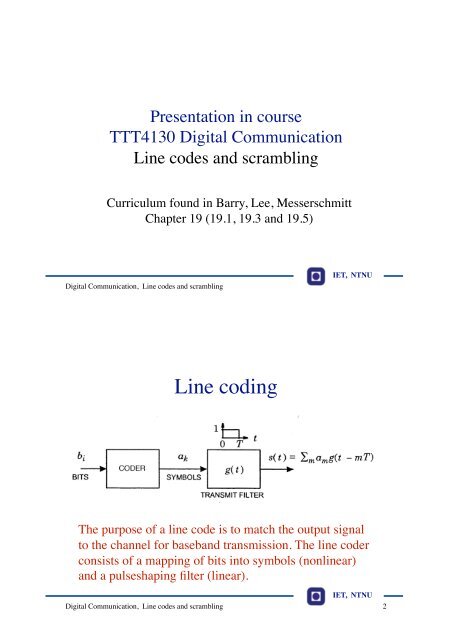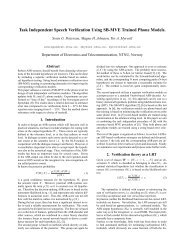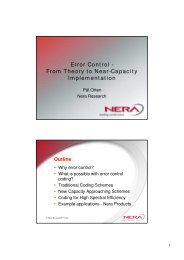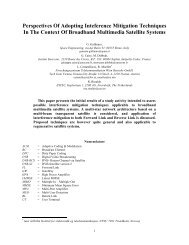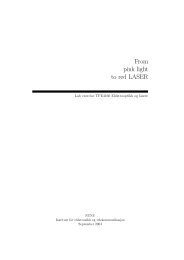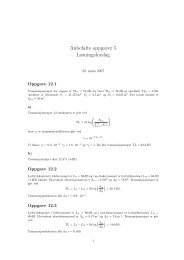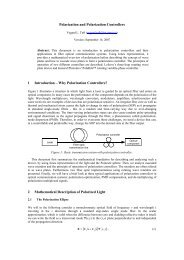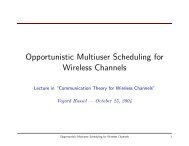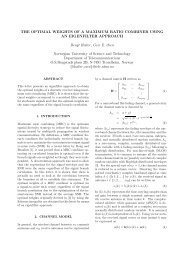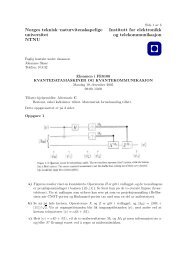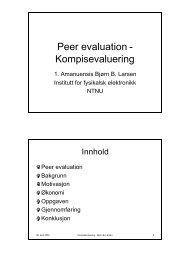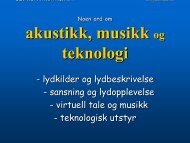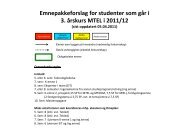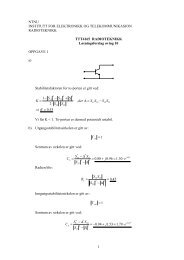Line coding - NTNU
Line coding - NTNU
Line coding - NTNU
You also want an ePaper? Increase the reach of your titles
YUMPU automatically turns print PDFs into web optimized ePapers that Google loves.
Presentation in course<br />
TTT4130 Digital Communication<br />
<strong>Line</strong> codes and scrambling<br />
Curriculum found in Barry, Lee, Messerschmitt<br />
Chapter 19 (19.1, 19.3 and 19.5)<br />
Digital Communication, <strong>Line</strong> codes and scrambling<br />
IET, <strong>NTNU</strong><br />
<strong>Line</strong> <strong>coding</strong><br />
The purpose of a line code is to match the output signal<br />
to the channel for baseband transmission. The line coder <br />
consists of a mapping of bits into symbols (nonlinear) <br />
and a pulseshaping filter (linear).<br />
Digital Communication, <strong>Line</strong> codes and scrambling<br />
IET, <strong>NTNU</strong><br />
2
Properties of line codes<br />
• Power spectrum<br />
• Timing recovery properties<br />
• DC-balance (zero DC component)<br />
• Redundancy<br />
• <strong>Line</strong>arity<br />
• Polarity independence<br />
Digital Communication, <strong>Line</strong> codes and scrambling<br />
IET, <strong>NTNU</strong><br />
3<br />
Efficiency and redundancy<br />
Maximum bitrate:<br />
R = f b · lb(L)<br />
(lb = log 2 ) <br />
L: no of output symbol levels<br />
f b : symbol rate in symb/s<br />
B: actual bitrate in bit/s<br />
Code efficiency:<br />
Redundancy:<br />
= B/R<br />
r = 1- <br />
Digital Communication, <strong>Line</strong> codes and scrambling<br />
IET, <strong>NTNU</strong><br />
4
Example, 4B3T code<br />
The 4B3T code is <strong>coding</strong> 4 input bits to 3 three-level <br />
symbols (2 4 = 16 combinations of input and 3 3 = 27 potential output <br />
combinations).<br />
Maximum bitrate:<br />
R = f b · lb 3<br />
Actual bitrate: B = f b · 4/3<br />
Code efficiency: = R/B = 4/(3·lb 3) = 0.84<br />
Redundancy: r = 1- 0.84 = 0.16<br />
Digital Communication, <strong>Line</strong> codes and scrambling<br />
IET, <strong>NTNU</strong><br />
5<br />
<strong>Line</strong>ar codes<br />
Input symbols are a k = ±1 and pulseshapes are defined in Fig 19.2 <br />
Biphase has zero DC component in each pulse<br />
RZ and NRZ may have a DC component<br />
Biphase and RZ has transitions in each pulse ): good timing properties<br />
NRZ may have long sequences of +1 or -1 ): poor timing properties <br />
Digital Communication, <strong>Line</strong> codes and scrambling<br />
IET, <strong>NTNU</strong><br />
6
Coded sequences<br />
Digital Communication, <strong>Line</strong> codes and scrambling<br />
IET, <strong>NTNU</strong><br />
7<br />
AMI code (Alternate Mark Inversion)<br />
<br />
a k<br />
= 0 b = 0 k<br />
<br />
±1 b k<br />
=1 (alternating 1 and +1)<br />
The AMI code may be generated <br />
as shown in the figure:<br />
b k<br />
= 0: c k<br />
= c k1<br />
a k<br />
= 0<br />
b k<br />
=1: c k<br />
c k1<br />
a k<br />
=±1<br />
c k<br />
changes between 0 and 1each time b k<br />
=1<br />
+ zero DC component<br />
- may contain long sequences of 0 (poor timing recovery) <br />
Digital Communication, <strong>Line</strong> codes and scrambling<br />
IET, <strong>NTNU</strong><br />
8
DC-balance<br />
Most transmission systems will be a.c. coupled. In metallic <br />
cables a transformer is used to avoid overvoltages. A.c. coupling <br />
may also be used due to implementation aspects. A.c. coupling<br />
means that d.c. is filtered out in a high-pass filter as shown in<br />
Fig 19.1a. This causes a slowly varying InterSymbol Interference<br />
that is denoted baseline wander. A Nyquist channel + a high pass<br />
filter in cascade will give a model for ISI as shown in Fig 19.1b. <br />
= 2RC = exp(-T/)<br />
Digital Communication, <strong>Line</strong> codes and scrambling<br />
IET, <strong>NTNU</strong><br />
9<br />
Running digital sum<br />
By assuming = 1, the overall time discrete impulse response may be <br />
approximated:<br />
0 k < 0<br />
<br />
p k<br />
= p(kT) = 1 k = 0<br />
<br />
T / k > 0<br />
Output signal at time k: y k<br />
= a m<br />
p km<br />
= a k<br />
T <br />
<br />
<br />
m=<br />
k1<br />
a m<br />
<br />
m=<br />
= a k<br />
T S k1<br />
Running digital sum, RDS: S k<br />
=<br />
Intersymbol interference at time k: ISI(k) = T S k1<br />
k<br />
<br />
m=<br />
a m<br />
max(ISI) = T min(S k1 ),<br />
max(ISI) for independent a k<br />
For a balanced line code RDS is bounded, and the DC content is zero.<br />
Digital Communication, <strong>Line</strong> codes and scrambling<br />
IET, <strong>NTNU</strong><br />
10
Impulse response for DC cutoff,<br />
simulation example illustrating baseline wander<br />
Cosine rolloff 100% +<br />
H( f )=<br />
j<br />
j +2 0.02<br />
3 dB cutoff frequency:<br />
0.02/T <br />
=T/(2·0.02)=7.96T<br />
Digital Communication, <strong>Line</strong> codes and scrambling<br />
IET, <strong>NTNU</strong><br />
11<br />
Eye curve for NRZ code with DC cutoff<br />
Cosine rolloff 100% +<br />
H( f )=<br />
j<br />
j +2 0.02<br />
NRZ is an unbalanced <br />
line code ): serious <br />
baseline wander<br />
Digital Communication, <strong>Line</strong> codes and scrambling<br />
IET, <strong>NTNU</strong><br />
12
Eye curve for AMI code with DC cutoff<br />
Cosine rolloff 100% +<br />
H( f )=<br />
j<br />
j +2 0.02<br />
AMI is a balanced <br />
line code ): small ISI<br />
Digital Communication, <strong>Line</strong> codes and scrambling<br />
IET, <strong>NTNU</strong><br />
13<br />
Power spectrum of a line code<br />
Transmitted signal:<br />
X(t) =<br />
<br />
a k<br />
g(t kT)<br />
k=<br />
Power spectrum:<br />
S X<br />
( f ) = 1 T S a (e j 2 fT ) G( f ) 2<br />
S a (z) : Time discrete power spectrum of sequence {a k } <br />
Digital Communication, <strong>Line</strong> codes and scrambling<br />
IET, <strong>NTNU</strong><br />
14
Power spectrum NRZ code<br />
Digital Communication, <strong>Line</strong> codes and scrambling<br />
IET, <strong>NTNU</strong><br />
15<br />
Power spectrum Biphase<br />
Digital Communication, <strong>Line</strong> codes and scrambling<br />
IET, <strong>NTNU</strong><br />
16
Power spectrum AMI code<br />
Digital Communication, <strong>Line</strong> codes and scrambling<br />
IET, <strong>NTNU</strong><br />
17<br />
Power spectrum for three simple codes <br />
NB: All codes<br />
have equal<br />
average power <br />
Digital Communication, <strong>Line</strong> codes and scrambling<br />
IET, <strong>NTNU</strong><br />
18
Comparison of simple codes<br />
Code Balanced Timing properties Minimum bandwidth<br />
RZ no good 1/(2T)<br />
NRZ no poor 1/(2T)<br />
Biphase yes good 1/T<br />
AMI yes poor 1/(2T)<br />
Digital Communication, <strong>Line</strong> codes and scrambling<br />
IET, <strong>NTNU</strong><br />
19<br />
Ternary (3-level) codes<br />
An kBnT block code is <strong>coding</strong> k bits into n 3-level symbols<br />
Digital Communication, <strong>Line</strong> codes and scrambling<br />
IET, <strong>NTNU</strong><br />
20
One alternative of a 4B3T code<br />
Digital Communication, <strong>Line</strong> codes and scrambling<br />
IET, <strong>NTNU</strong><br />
21<br />
Binary codes<br />
Binary codes are relevant for optical transmission.<br />
The number of balanced codewords of length n is given by:<br />
N =<br />
n!<br />
(n /2)!(n /2)!<br />
Corresponding codes are shown in the table<br />
Due to low efficiency, nBmB codes are used instead, where<br />
m = n +1 (e.g. 5B6B)<br />
Digital Communication, <strong>Line</strong> codes and scrambling<br />
IET, <strong>NTNU</strong><br />
22
Partial response<br />
c k = ±1<br />
F(z)<br />
y k <br />
F(z) = (1 - z -1 ) m · (1 + z -1 ) n<br />
Digital Communication, <strong>Line</strong> codes and scrambling<br />
IET, <strong>NTNU</strong><br />
23<br />
Alternatives of partial response<br />
Type partial response n = m = F(z)=<br />
Dicode 0 1 1-z -1<br />
Duobinary 1 0 1+z -1<br />
Modified duobinary 1 1 (1+z -1 )(1-z -1 )=1-z -2<br />
1 z 1 =1 exp( j2fT) = 2 j exp( jfT) sin(fT), ) : zero at f = 0<br />
1+ z 1 =1+ exp( j2fT) = 2 exp( jfT) cos(fT), ) : zero at f =1/(2T)<br />
Digital Communication, <strong>Line</strong> codes and scrambling<br />
IET, <strong>NTNU</strong><br />
24
Duobinary partial response<br />
y k = c k + c k-1<br />
c k c k-1 Output y k<br />
-1 -1 -2<br />
-1<br />
1 0<br />
1 -1 0<br />
1 1 2<br />
For duobinary, a two-level signal is coded into three <br />
levels. Modified duobinary and dicode will also have<br />
three-level output for binary input. Other alternatives<br />
of partial response will have more output levels. <br />
Digital Communication, <strong>Line</strong> codes and scrambling<br />
IET, <strong>NTNU</strong><br />
25<br />
Spectral shaping by partial response<br />
Digital Communication, <strong>Line</strong> codes and scrambling<br />
IET, <strong>NTNU</strong><br />
26
De<strong>coding</strong> of partial response<br />
? c k - c k-1 <br />
c k - c k-1 <br />
c k - c k-1 <br />
c k-1 <br />
c k-1 <br />
Digital Communication, <strong>Line</strong> codes and scrambling<br />
IET, <strong>NTNU</strong><br />
27<br />
Pre<strong>coding</strong> of partial response (duobinary)<br />
Precoder<br />
Convert to<br />
bipolar<br />
b k = 0,1 d k = 0,1<br />
<br />
0 to -1<br />
c k = ±1 a k ˆ<br />
+<br />
1 to +1<br />
z -1 z -1<br />
Digital Communication, <strong>Line</strong> codes and scrambling<br />
Duobinary <br />
<strong>coding</strong><br />
b k<br />
= 0 d k<br />
= d k1<br />
c k<br />
= c k1<br />
a k<br />
= c k<br />
+ c k1<br />
=±2 b ˆ<br />
k<br />
= 0<br />
b k<br />
=1 d k<br />
d k1<br />
c k<br />
c k1<br />
a k<br />
= c k<br />
+ c k1<br />
= 0 b ˆ<br />
k<br />
=1<br />
3-level<br />
decision<br />
De<strong>coding</strong> depends only on current received signal sample ):<br />
no error propagation.<br />
Pre<strong>coding</strong> may be used also for modified duobinary and dicode.<br />
IET, <strong>NTNU</strong><br />
b k<br />
28
Scrambling<br />
• Most transmission systems are based on an assumption of<br />
random input data ): statistically independent bits and<br />
p(“0”) = p(“1”) = 1/2<br />
• Practical input data often differ from this assumption and<br />
may for instance contain long strings of ones or zeroes<br />
• Scrambling is a way to ensure approximately random data<br />
• Scrambling is based on pseudorandom sequences<br />
generated by linear feedback shift registers.<br />
Digital Communication, <strong>Line</strong> codes and scrambling<br />
IET, <strong>NTNU</strong><br />
29<br />
<strong>Line</strong>ar feedback shift register<br />
Number of states in a shift register of length n: 2 n<br />
The output sequence is periodic, and for a<br />
maximum length shift register the period is: 2 n -1 <br />
Digital Communication, <strong>Line</strong> codes and scrambling<br />
IET, <strong>NTNU</strong><br />
30
Frame-synchronized scrambler<br />
Assuming error free transmission:<br />
ˆ b k<br />
= ˆ c k<br />
x k<br />
= c k<br />
x k<br />
= b k<br />
x k<br />
x k<br />
= b k<br />
- The transmitter and receiver shift registers have to be synchronized<br />
+ One bit error per transmission error<br />
Digital Communication, <strong>Line</strong> codes and scrambling<br />
IET, <strong>NTNU</strong><br />
31<br />
Self synchronized scrambler<br />
Assuming error free transmission:<br />
b ˆ<br />
k<br />
= c ˆ k<br />
d ˆ<br />
k<br />
= c k<br />
d k<br />
= b k<br />
d k<br />
d k<br />
= b k<br />
+ Automatic synchronization<br />
- Minimum three bit errors per transmission error<br />
Digital Communication, <strong>Line</strong> codes and scrambling<br />
IET, <strong>NTNU</strong><br />
32
Applications of scrambling<br />
• Echo cancelling <br />
– Two different scramblers, one for each<br />
direction of transmission <br />
• Synchronization<br />
• Adaptive equalization<br />
• Interference cancellation<br />
• ...<br />
Digital Communication, <strong>Line</strong> codes and scrambling<br />
IET, <strong>NTNU</strong><br />
33<br />
Maximum length shift registers<br />
Digital Communication, <strong>Line</strong> codes and scrambling<br />
IET, <strong>NTNU</strong><br />
34
Table of maximum length shift registers<br />
Digital Communication, <strong>Line</strong> codes and scrambling<br />
IET, <strong>NTNU</strong><br />
35


